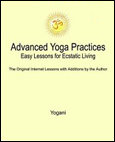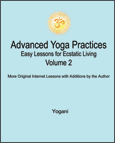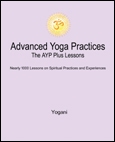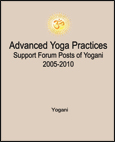|
Public Home | Plus Home | Main Lessons | Tantra Lessons | Public Forum | Plus Forum | Downloads | Books Topic Paths | Search | Training-Retreats | Testimonials | Survey | Interviews | MultiMedia | Contact | Donate |
|
Advanced Yoga Practices Note: For the Original Internet Lessons with additions, see the AYP Easy Lessons Books. For the Expanded and Interactive Internet Lessons, AYP Online Books, Audiobooks and more, see AYP Plus. Lesson 356 - How to Recognize Relational Self-Inquiry (Audio)
AYP Plus Additions:
From: Yogani New Visitors: It is recommended you read from the beginning of the archive, as previous lessons are prerequisite to this one. The first lesson is, "Why This Discussion?"
A: A good way to recognize relational self-inquiry is in noticing what it is not. If there is strain, expectation, intellectualizing, judgment, frustration, headache, etc., those would be signs of non-relational self-inquiry, and it is best to lighten up (self-pace) in those instances. With the rise of inner silence (witness), those symptoms will be less present, and we will simply be noticing thoughts and feelings to be objects in our awareness, no longer classifying them or hanging on to them, no longer seeing them as extensions of our self, or as "baggage" to be carried around. They will be seen to be outside our sense of self. If inquiry is increasingly joyful and luminous, through both "good times" and "bad times," we can be sure it is becoming relational. That is, released in stillness (the witness). For a progression of stages in self-inquiry, see Lesson 350. It is a long lesson, but one of the clearer ones so far on the various stages and styles of self-inquiry. The term "relational" was coined to identify the relationship between abiding inner silence (the witness) and thoughts. That relationship consummates with the natural release (letting go) of thoughts in stillness, the blending of one into the other, which is also samyama. It is the basis of effective self-inquiry, divine outpouring, stillness in action, spontaneous siddhis (small and large), and freedom from the ups and downs of this world, even as we remain active in it. Prior to the rise of inner silence as an abiding presence, this relationship cannot occur. Then it is thoughts interacting with thoughts with the aforementioned problematic symptoms. The term for that is "non-relational," meaning thoughts not occurring in relationship to stillness. See Lesson 325 for more on relational and non-relational self-inquiry. The reason why these terms have been developed and emphasized in the lessons on self-inquiry, is to clarify the essential point that self-inquiry is not a viable practice without at least the beginnings of the witness stage. It is not difficult to cultivate in deep meditation, but this is often ignored in neo-advaita teachings. I say "neo-advaita" because if we dig a bit we will find that the great advaita and jnana yoga teachers clearly recognized the role of the witness, bhakti, and yoga practices. Modern neo-advaita is prone to strip it all down to the bare logic and expect that to be an effective "stand-alone" approach for everyone at every point on the path. Clearly it is not. So "relational" and "non-relational" have been born in an attempt to make as clear as possible the distinction between self-inquiry with witness and self-inquiry without witness. The experiences of many in the AYP community of practitioners have verified the development of this dynamic through daily yoga practices, with our inquiries moving steadily from non-relational to relational. Whatever we may choose to call it, the shift is quite noticeable. Many are delving into self-inquiry these days with pretty good results, whereas, a few years ago it was, well, non-relational, and of less relevance. That is changing as more and more practitioners are finding abiding inner silence coming up in their lives. This is why we have been focusing more on self-inquiry at this stage in the AYP lessons. It would have made little sense in the beginning. All things in their own good time. As with any term that indicates a stage or milestone, we don't want to be turning "relational" and "non-relational" into have and have-not labels. That is not their purpose. The purpose is to inspire the continued favoring of daily deep meditation (and samyama) when self-inquiry is not yet gaining traction. If there were no clear guidance offered on this, there may be a tendency to beat our head against the wall for a long time in thought-based only self-inquiry, and/or succumb to frustration and drop spiritual practices altogether. We'd like to avoid such scenarios, and so point to a more practical approach with clear navigation milestones we can notice along the way. Then we can pace our practices accordingly for best results. The recent addition of a powerful self-inquiry sutra to core samyama practice in Lesson 351 is also for the purpose of helping smooth the transition from non-relational to relational inquiry. This can be included as soon as we are able to undertake core samyama practice, and it does not carry the risks of outright non-relational self-inquiry, even if the presence of our abiding witness is at an early stage. The guru is in you. Discuss this Lesson in the AYP Plus Support Forum Note: For detailed discussion on the practical utilization of self-inquiry, and on how to avoid ineffective uses of self-inquiry, see the Self-Inquiry book and the Liberation book, and AYP Plus. |
|
|
|
Join the Mail List:
AYP Retreats
eBooks - PDF, EPUB
FREE eBooks with
SAVE with Bundled
|

























